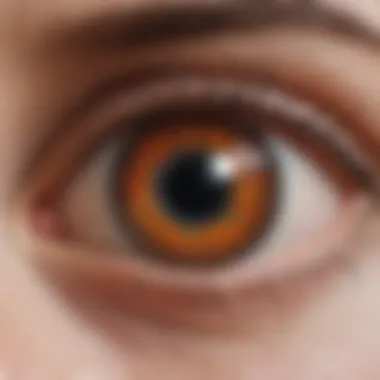Eye Problems Linked to Rheumatoid Arthritis


Research Context
Background Information
Rheumatoid arthritis (RA) is an autoimmune disorder that primarily targets the joints, causing inflammation and pain. However, its systemic effects extend beyond joints, impacting various body systems, including the eyes. According to studies, as many as 30% of individuals with RA report experiencing eye-related symptoms. Understanding these ocular manifestations is essential as they can significantly affect a patient's quality of life and overall health.
Importance of the Study
Discussion
Interpretation of Results
Findings show that the most common eye problems linked with rheumatoid arthritis include dry eyes, scleritis, and uveitis. Dry eye syndrome occurs due to decreased tear production, often exacerbated by medications used to treat RA, such as methotrexate. Scleritis, characterized by inflammation of the white outer layer of the eye, can be both painful and visually threatening. Uveitis, an inflammation of the middle layer of the eye, may lead to serious complications if left untreated.
Comparison with Previous Research
Research from previous studies supports these findings. For example, a study published in the "Journal of Rheumatology" reported that eye problems often go undiagnosed in RA patients. This lack of awareness can lead to irreversible damage. Comparing these new insights with earlier works reveals a persistent need for increased educational efforts within the healthcare community regarding the ocular effects of RA, emphasizing the importance of routine eye examinations for affected individuals.
"Rheumatoid arthritis not only affects joints but can significantly impair visual health, which is often overlooked in patient care."
In summary, understanding the ocular manifestations of rheumatoid arthritis is critical. Enhanced awareness can lead to improved patient outcomes, making it necessary for this study to gain attention in both clinical practice and research.
Foreword to Rheumatoid Arthritis
Rheumatoid arthritis (RA) is not merely an affliction of the joints; it is a complex autoimmune disorder that can lead to a plethora of complications throughout the body. Understanding RA is crucial for comprehending its broad impact, particularly when it comes to ocular health. Eye problems linked with RA can be painful and can significantly diminish quality of life. Given that ocular manifestations may not always be recognized immediately, discussing RA in-depth lays the groundwork for addressing these consequences throughout this article.
Definition of Rheumatoid Arthritis
Rheumatoid arthritis is characterized as a chronic inflammatory disorder that affects the lining of the joints. It creates painful swelling, decreased mobility, and in the long term, joint deformity. Unlike osteoarthritis, which is a wear-and-tear condition, RA is driven by an autoimmune mechanism, where the body’s immune system mistakenly attacks its own tissues. This can cause not only joint damage but also systemic effects that may compromise other organs, including the eyes.
Epidemiology of Rheumatoid Arthritis
RA is a common condition, affecting approximately 1% of the global population. It typically occurs in middle-aged individuals but can develop at any age. The condition is approximately three times more prevalent in women than in men. Genetic predisposition, environmental factors such as smoking, and hormonal influences are thought to contribute significantly to the incidence and progression of RA. Understanding its epidemiological aspects is crucial as this information helps in identifying at-risk groups and tailoring appropriate interventions.
Overview of Autoimmune Conditions
Autoimmune diseases occur when the immune system, which normally protects the body from infections and diseases, malfunctions. Instead of attacking foreign pathogens, it mistakenly targets healthy cells. RA is one of many autoimmune conditions, including lupus and multiple sclerosis, that can lead to chronic inflammation and damage in various body systems. Recognizing the nature of autoimmune conditions establishes a framework for understanding RA’s diverse manifestations, including the ocular issues that can arise as a secondary complication.
The interplay between RA and ocular health highlights the necessity for comprehensive patient care involving both rheumatologists and ophthalmologists.
Understanding Ocular Health in RA
Rheumatoid arthritis (RA) is well known primarily for its impact on the joints, but its effects on ocular health are equally significant. Understanding ocular health in the context of RA is crucial for several reasons. Firstly, eye problems linked to RA can severely impact the quality of life. Symptoms like dryness, discomfort, or vision changes can affect daily activities and emotional well-being. Secondly, early recognition and treatment of these ocular manifestations can help preserve vision and prevent complications.
Considering the multifaceted nature of RA, it is pertinent to explore how systemic inflammation, which characterizes this disease, relates to eye health. The eyes contain delicate tissues that can be influenced by inflammatory processes. Therefore, maintaining awareness of potential ocular conditions is vital for effective management of RA overall.
Furthermore, engaging in a thorough understanding of ocular health provides insight into the interplay between autoimmune disorders and vision. It emphasizes a holistic approach to patient care, which can greatly benefit those living with RA. Physicians and patients alike must acknowledge these implications to ensure a proactive strategy towards eye health maintenance.
"The connection between rheumatoid arthritis and eye issues underscores the need for integrated healthcare strategies."
The Connection Between RA and Ocular Disorders
Rheumatoid arthritis exhibits a pattern of systemic inflammation. This inflammation doesn't only localize to the joints; other organs including the eyes are also affected. The connection arises mainly from immune system dysregulation. This dysregulation can provoke various ocular disorders. For instance, patients with RA are at increased risk for conditions like Sjögren’s syndrome and uveitis, both of which can lead to discomfort or vision changes.
Attachment of the inflammation affects the vascular structures in the eyes. Thus, patients may experience dryness due to reduced tear production, leading to symptoms of dry eye syndrome. Identifying and treating these disorders early enhances the overall management of RA and reduces the burden on patients.


Common Ocular Structures Affected
Certain ocular structures are more prone to damage due to the inflammatory nature of rheumatoid arthritis. Key structures include:
- Lacrimal glands: Responsible for tear production; inflammation can cause decreased secretion, leading to dry eyes.
- Uvea: The middle layer of the eye, where uveitis can occur, potentially causing severe vision loss if untreated.
- Cornea: Ulceration or inflammation can arise, significantly impacting vision clarity and comfort.
- Sclera and Episclera: Inflammation can lead to scleritis or episodic episodes of episcleritis, each with distinct symptoms and management needs.
Understanding these structures and the potential effects of RA provides crucial information for effective diagnosis and intervention. Correctly addressing these ocular issues contributes to improved patient outcomes, making it essential for healthcare providers to recognize these associations.
Types of Eye Problems Associated with RA
Sjögren’s Syndrome and Its Impact
Sjögren's syndrome often coexists with rheumatoid arthritis. This autoimmune condition primarily affects moisture-producing glands, leading to dry eyes and dry mouth. It occurs because the body’s immune system mistakenly attacks these glands.
The impact of Sjögren's syndrome can be profound. Patients may experience significant discomfort from dry eyes, which can lead to severe inflammation and increased risk of corneal damage. Chronic dryness can affect daily activities, leading to a decreased quality of life. While lubricating eye drops may provide symptom relief, managing this syndrome requires a multidisciplinary approach to ensure comprehensive care.
Uveitis in Rheumatoid Arthritis
Uveitis is inflammation of the uvea, the middle layer of the eye. In RA patients, this condition can lead to serious complications such as vision loss if not addressed promptly. Symptoms include redness, pain, and blurred vision. The inflammatory response is due to underlying immune system dysregulation common in RA.
Treatment usually involves corticosteroids or other anti-inflammatory medications. An early diagnosis is critical. Regular ophthalmologic evaluations are essential for patients with rheumatoid arthritis to catch uveitis before it progresses.
Corneal Ulceration and Inflammation
Corneal ulceration is another serious eye complication linked to rheumatoid arthritis. This occurs when the cornea becomes inflamed, leading to the formation of ulcers. Risk factors include dryness associated with Sjögren's syndrome as well as direct inflammation from RA. Symptoms include pain, redness, and visual disturbances.
Management typically necessitates aggressive treatment with antiviral or antibiotic medications. In some cases, surgical intervention may be necessary when the ulcer does not respond to medical therapy. Awareness of corneal health is crucial for patients at risk to maintain optimal visual function.
Episcleritis and Scleritis
Episcleritis is a mild inflammatory condition affecting the episclera, while scleritis is a more severe inflammation involving the sclera, the outer layer of the eye. Both are associated with rheumatoid arthritis and can cause symptoms such as pain and redness.
Episcleritis typically resolves on its own, but scleritis may require treatment with systemic medications. The latter can affect vision and may be a sign of systemic disease activity. Regular follow-ups are necessary to monitor the condition and adjust treatments as needed.
Dry Eye Syndrome
Dry eye syndrome, prevalent among those with rheumatoid arthritis, can be debilitating. This condition occurs when the eyes do not produce enough tears or when tears evaporate too quickly. Symptoms include burning, irritation, and a feeling of grittiness.
The management of dry eye syndrome may involve the use of artificial tears, anti-inflammatory medications, or punctal plugs to retain tear moisture. Lifestyle modifications, such as using humidifiers or adjusting screen time, can also help alleviate symptoms.
Diagnosing Eye Problems in RA Patients
Clinical Presentation and Symptoms
The clinical presentation of eye problems in RA patients can vary, making it vital to understand what signs to look for. Symptoms may include dryness in the eyes, redness, pain, and blurred vision. These symptoms can be subtle or severe, and their onset may be gradual or sudden. Some common presentations are:
- Dry Eye: A frequent complaint due to reduced tear production. Patients may experience a burning or sandy sensation in the eyes.
- Sensitivity to Light: Increased photophobia can occur, making it uncomfortable for patients to be in bright light.
- Eye Redness: This can be due to inflammation or irritation of the ocular surface.
Patients may brush off these symptoms or attribute them to fatigue, leading to delay in diagnosis. Recognizing these signs early can lead to better management and prevent further damage.
Diagnostic Techniques and Tools
A variety of diagnostic techniques play a significant role in evaluating eye problems in RA patients. These diagnostics not only help in identifying the specific condition but also guide appropriate treatment. Some key techniques include:
- Slit Lamp Examination: This allows the ophthalmologist to closely examine the structures of the eye, including the cornea, lens, and retina.
- Tear Breakup Time Test: This assesses the stability of the tear film, helping to diagnose dry eye syndrome.
- Ocular Imaging: Techniques such as optical coherence tomography (OCT) can provide detailed cross-sectional images of the retina and other eye structures, facilitating early detection of diseases like uveitis.
Utilization of these advanced tools can enable better diagnosis and tailored management for patients.


Role of Ophthalmic Examination
A thorough ophthalmic examination is vital for all RA patients. Regular check-ups help in monitoring ocular health and detecting any changes early. During the examination, the ophthalmologist will assess:
- Visual Acuity: Monitoring changes in vision can signal developing eye problems.
- Intraocular Pressure: Elevated pressure can be a sign of conditions like glaucoma.
- Evaluation of Conjunctiva and Sclera: This helps in identifying inflammation or other abnormalities.
Early detection through routine ophthalmic examinations can significantly alter the treatment approach, ultimately improving patient outcomes.
Pathophysiology of Ocular Manifestations in RA
Understanding the pathophysiology behind ocular manifestations in rheumatoid arthritis (RA) is crucial. It provides insights into how systemic autoimmune processes influence eye health. This section explores the interplay of inflammation, immune system dysregulation, and genetic factors.
Inflammatory Mechanisms
Inflammation plays a dominant role in the ocular problems seen in RA patients. Inflammatory mediators, such as cytokines and chemokines, create an environment that affects ocular tissues. These substances attract immune cells to the eyes, contributing to conditions such as scleritis and uveitis.
The persistent inflammation can damage eye structures over time. For example, the conjunctiva, cornea, or even the retina may experience harm. Moreover, this inflammation is often bilateral, affecting both eyes simultaneously. Awareness of these mechanisms is vital for timely diagnosis and treatment.
Immune System Dysregulation
In RA, the immune system fails to distinguish between self and non-self, leading to attacks on the body's tissues, including the eyes. Dysregulation results in a misfiring immune response which drives the chronic inflammation observed in ocular conditions.
This mismanagement can often lead to dry eye syndrome due to decreased tear production. Furthermore, immune system anomalies may predispose individuals to secondary infections in the ocular regions, complicating the management of RA-related eye issues. Evaluating immune function in RA patients is critical for effective care.
Contributions of Genetic Factors
Genetics can significantly influence ocular manifestations in RA. Certain genetic markers increase the risk of developing eye problems in these patients. For instance, human leukocyte antigen (HLA) alleles have been implicated in susceptibility to both RA and associated scleritis.
Moreover, familial patterns of RA suggest that inherited factors play a role in how individuals experience ocular complications. Understanding these genetic influences aids in predicting which patients may be at higher risk, hence allowing for more personalized and proactive health management.
"The interplay of inflammation, immune dysregulation, and genetic vulnerability profoundly shapes the ocular landscape in rheumatoid arthritis."
Recognizing the pathophysiological foundations of ocular issues not only informs clinical practice but is essential for advancing research in treatment and management strategies. It highlights the need for an integrative approach that considers systemic health to enhance ocular well-being in RA patients.
Management and Treatment Options
Specific elements to focus on include:
- Accurate diagnosis of eye conditions linked to RA.
- Tailored treatment strategies based on individual patient needs.
- Inclusion of a multidisciplinary approach to address both ocular and systemic symptoms.
Potential benefits:
- Improved eye health and functionality.
- Minimized risks of severe ocular complications.
- Enhanced patient satisfaction and lifestyle quality.
Medications for Eye Conditions in RA
Medications play a pivotal role in managing eye conditions arising from rheumatoid arthritis. Typical medications used include corticosteroids, non-steroidal anti-inflammatory drugs, and immunosuppressives. Corticosteroids, for instance, can help reduce inflammation in conditions such as uveitis, which is prevalent among RA patients.
Additionally, specific topical treatments for dry eye, such as artificial tears and cyclosporine A, are often utilized to alleviate symptoms. It is crucial for patients to consult with their ophthalmologist regularly to adjust their medication based on the severity of eye symptoms and any potential side effects from systemic RA treatments.
Surgical Interventions When Necessary
In some cases, surgical interventions become necessary when medications and other conservative measures fail to provide adequate relief. For example, patients with severe corneal disease may require corneal transplantation, while others may benefit from eyelid surgery to address issues related to dry eyes or ectropion.
Surgery is generally considered a last resort and is typically reserved for cases where vision is at risk or significant discomfort persists. Therefore, surgical options should be thoroughly discussed with both the rheumatologist and the ophthalmologist to weigh the benefits against risks.
The Role of Systemic Treatment for RA Patients


Systemic treatments for rheumatoid arthritis, such as disease-modifying antirheumatic drugs (DMARDs) and biopharmaceuticals, play a significant role in the overall management of ocular issues. These treatments can help control the inflammatory process that underlies both joint and eye diseases.
Moreover, biologics like adalimumab and rituximab have demonstrated effectiveness not just in managing RA but also in alleviating ocular inflammation in some patients. Regular monitoring and adjustments of these systemic treatments can lead to improved outcomes and help manage the patient's overall health, including ocular manifestations.
It is essential to take an individualized approach to treatment, considering all underlying factors of each patient’s condition.
Ultimately, the collaboration among rheumatologists, ophthalmologists, and primary care providers is crucial in achieving optimal management of eye problems linked to rheumatoid arthritis.
Collaborative Care Models
Collaborative care models are integral in managing the multifaceted health concerns associated with rheumatoid arthritis, particularly regarding ocular problems. In this context, a coordinated approach among healthcare providers can significantly improve patient outcomes. By fostering communication across various specialties, including rheumatology, ophthalmology, and primary care, these models ensure that patient care is consistent and effective.
Importance of Multidisciplinary Approach
A multidisciplinary approach to care combines the expertise of different healthcare professionals. Each specialist brings a unique perspective that enhances the understanding of rheumatoid arthritis and its ocular complications. For instance, rheumatologists can manage the systemic aspects of RA, while ophthalmologists focus on specific eye-related issues. This collaboration allows for more comprehensive treatment plans that address both the inflammatory nature of RA and its potential impact on ocular health.
- Enhanced Communication: Clear communication channels among various specialists ensure that all aspects of a patient's condition are considered.
- Holistic Treatment Plans: Patients benefit from tailored strategies that not only focus on joint health but also prioritize eye health.
- Improved Patient Outcomes: Studies indicate that patients receiving multidisciplinary care experience better management of their symptoms and overall health.
Ongoing education about RA's ocular implications is vital for all professionals involved. Regular discussions and seminars can help in keeping every member updated with the latest research and treatment methods.
Preventive Strategies and Education
Preventive strategies play a crucial role in maintaining ocular health in patients with rheumatoid arthritis. Education regarding potential eye problems can empower patients and prompt them to seek timely intervention. Effective strategies include:
- Regular Eye Examinations: Given the risk associated with RA, routine eye check-ups should be emphasized. This helps in early detection of conditions like uveitis or dry eye syndrome.
- Patient Education: Patients need clear information about the symptoms associated with ocular problems. Understanding signs like redness, light sensitivity, or persistent dryness can lead to quicker responses to eye issues.
- Healthy Lifestyle Choices: Educating patients about the importance of a balanced diet, hydration, and managing stress levels can positively impact their overall health, including eye health.
"Education and prevention are just as crucial as treatment in managing rheumatoid arthritis and its related eye problems."
By implementing collaborative care models, healthcare systems can not only provide better individual care but also enhance the understanding of patient needs across disciplines. This systematic approach results in comprehensive care that addresses the complex nature of RA and its implications for ocular health.
Future Directions in Research
Research on eye problems linked to rheumatoid arthritis (RA) is essential for several reasons. First, understanding the connection between RA and ocular health can lead to improved treatment protocols. It is crucial for both clinicians and researchers to delve into innovative approaches that specifically address the ocular manifestations of RA. With the increasing prevalence of autoimmune diseases, focusing on how these conditions affect the eyes can enhance patient quality of life.
The integration of multidisciplinary strategies is necessary. Ocular symptoms may often be overlooked in the management of RA, leading to suboptimal care. By prioritizing research on eye-related issues, healthcare professionals can devise comprehensive treatment plans that encompass both rheumatological and ophthalmological concerns. This can ultimately promote better patient outcomes and more effective management of symptoms.
Emerging Therapies for RA-Related Eye Problems
The landscape of treatment options for eye problems associated with RA is evolving. Emerging therapies are addressing specific ocular manifestations, showing promise in clinical trials and observational studies. For instance, biologic agents used for RA, such as Rituximab, have been studied for their effectiveness in treating related ocular conditions like uveitis and scleritis. These treatments focus on targeted therapy, minimizing systemic side effects while maximizing efficacy.
Investigation into corticosteroid therapies is also significant. New delivery systems, such as intraocular injections and implants, can improve the treatment of inflammation without exposing patients to systemic side effects. For example, dexamethasone implants are increasingly considered in cases of persistent inflammatory conditions, ensuring localized treatment.
Potential Biomarkers for Early Detection
The identification of biomarkers plays a crucial role in the management of RA-related eye problems. Biomarkers can serve as indicators of disease activity, providing insights into the onset of ocular complications. For RA patients, early detection of ocular manifestations allows for prompt intervention, reducing the risk of permanent damage or loss of vision.
Research efforts are ongoing to identify reliable biomarkers. For instance, proteins associated with inflammation and autoimmunity are being studied. These can offer predictive value for ocular surface diseases, such as Sjögren’s syndrome, which frequently co-occurs with RA. Advances in genetics and proteomics might uncover new biomarkers, leading to tailored therapies that could enhance the quality of life for patients.
By focusing on these future directions, the field can ultimately provide more nuanced and effective management strategies for individuals suffering from both rheumatoid arthritis and its ocular complications. The resulting insights will not only enhance clinical practice but also foster a collaborative spirit between rheumatologists and ophthalmologists.
Epilogue
Summary of Key Insights
Rheumatoid arthritis extends beyond joint inflammation and affects ocular health significantly. Key insights from this article include:
- Variety of Eye Conditions: The range of ocular complications linked to RA includes Sjögren’s syndrome, uveitis, and dry eye syndrome. Each carries unique risk factors and necessitates distinctive management strategies.
- Impact of Inflammation: The inflammatory pathways that are central to RA also drive ocular complications, emphasizing the need for a multidisciplinary approach.
- Diagnosis and Management: Effective management of these eye conditions hinges on both prompt diagnosis and a tailored treatment plan that may involve medications, surgical intervention, and systemic RA treatments.
"Understanding the connection between rheumatoid arthritis and eye health is essential for holistic patient care."
Final Thoughts on Comprehensive Care
A strategic, comprehensive care model is essential in treating RA patients with ocular issues. The integration of ophthalmological care with rheumatological treatment fosters an environment where eye health is prioritized alongside joint health. Educational initiatives that inform patients and healthcare providers about the potential eye problems linked to rheumatoid arthritis can enhance early recognition and treatment effectiveness.















